Situated around 45 kms from Leh, Hemis Monastery is the biggest among the monasteries of Ladakh. The monastery was built in 1630 CE. The decorated white walls and colourful prayer flags made the monastery an astonishing one.
The monastery is one of the important libraries for Tibetan books and possesses valuable and impressive Thangas, various gold statues and Stupas.
Hemis is well known for Hemis Festival, celebrated usually in June-July for 2 days. The festival was to commemorate the birth of Guru Padmasambhava. The festival symbolises the victory of good over bad.
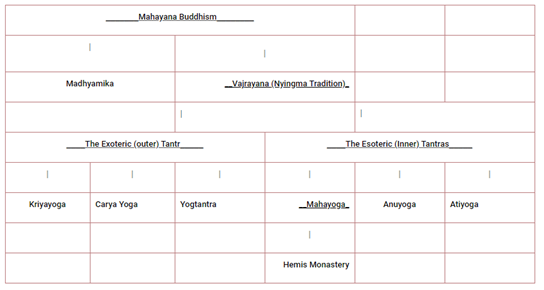
Chart Credit: Indira Gandhi National Centre for the Arts
Hemis Monastery:
Hemis Monastery, also known as Himis Gompa or Hemis Gompa, is among the best known and largest monastery situated in the Ladakh region of North India. The richness of the monastery was mentioned in various works of literature. Founded in the 17th century by Stagsan Raspa, the monastery belongs to the Drukpa Kagyupa sect. The monastery has close associations with the royal family of Ladakh.
The monastery covers an area around 2,500 acres of Ladakh and Zanskar area in the valley of the Stok Kangri mountain range. There are many other monasteries too, which are situated in the cardinal directions of the Hemis monastery. They are Chemrey, Hanle and Timosgong.
Stagsan Raspa, who founded the monastery, was born in 1574 CE. He was a Mahasiddha. Jamyang Namgyal, who was the ruler of Ladakh, invited Stagsan Raspa in his court. His wish was fulfilled by his son, Senge Namgyal.
The Ladakh royal family was introduced to the teachings of the Drukpa Kagyupa sect by Gotsangpa. Gotsangpa was a student of Drukchen. He was believed to have meditated in a cave in Shang Valley, thus, since than Shang Valley is usually associated with the Drukpa sect.
Regarding the construction of the monastery, an inscription was found in the main complex. The inscription dates the construction from 1644 CE to 1664 CE. The first structure is now known as Nyingma Lhakhang meaning old shrine.
Stagsan Rasapa passed away in1651 and his lineage have been continuous be his incarnations. The next incarnation was Nawang Sakya Dorje from Lahul. The current incarnation, Nawang Tenzin Chokyi Nyima is sixth in lineage and ordained by the 14th Dalai Lama.
Architecture:
Unlike other structures in Ladakh, Hemis monastery has Tibetan Architectural styles. The monastery has the main shrine accompanied by mini quarters for monks. The main courtyard is adorned with various structures. The main prayer hall of the monastery is Dukhang Barpa and Dhukhang Chenmo. After the damage, the visitors’ gallery was reconstructed in 1996. The gallery housed many valuable painting series of Mahasiddhas. The topic of the paintings is unique and many of them are now kept in the prayer hall with mantras carved on them. All the 84 panels are a depiction of Mahasiddhas or pantheon of Drukpa Kagyupa lineage. In between, the main panel depicted the Shakyamuni Buddha with his disciples.
Various artefacts were now shifted to a museum located near the visitors’ gallery and library.
Hemis Festival:
Hemis Festival was introduced by Gyalsras Rinpoche around 1730 CE. It is celebrated every year on the 10th day of the fifth month according to the Buddhist Calendar, which falls usually in May-June. It marks the birth anniversary of Guru Padmasambhava. The Guru is the founder of lama tradition and the main authority of Tibetan Buddhism.
Guru Padmasambhava visited Tibet, and he convinced Lamas of Tibet that he is the incarnation of Buddha. Thus, on his birth anniversary, the festival celebrates his great teachings and symbolises the triumph of good over evil, as he saved the Dharma of Buddha.
Guru Padmasambhava is well known as Guru Rinpoche, meaning the precious teacher. Nyingmas honoured him next to Buddha. He possessed various extraordinary powers and it is said that he was born in a lotus. After, he lived a life of an ascetic, and during his whole life, he educated peoples about the approaches for enlightenment.
Usually, festivals are celebrated in winter in the region of Ladakh, the only exception is Hemis or Thseshu festival, which is held in summer.
The festival is celebrated in the courtyard of the monastery. The courtyard had a beautiful and well-planned performance space, in front of the main door of the monastery. Various musicians play traditional music accompanied by Lamas. The main aim of sacred performance and the dances are to bestow good health, to prevent and heal diseases and to conquer evil spirits.
During the festivals, various rituals were performed, Dukhang Barpa being the centre among them. Monks with other dancers, known as Chhamspon chheva, performs a mystical dance called Cham. The Cham or mask dance is an essential part of Tantric tradition. It is performed in special gompas, which were followed by Vajrayana teachings. The performance is strictly based on the prescribed texts, which are orally transmitted from generations. In the Cham dance, dancers wear masks and costumes, belongs to various deities. Every monk assumes the personality and symbolizes any particular deity.
Dance is accompanied with Tibetan ritual music. The origin of music is found in the teachings of dakinis. According to a legend, a Lama named Takpo Dorjechang, transmitted the music through dakinis in very complex and beautiful form.
Usually, with the dance, music symbolises an offering to the deities. Music is differentiated according to the deity and expresses the nature of deity.
Tsamchot Dance: Tsamchot Dance is also known as Black Hat dance. Dancers wear large black hats, they are total 13 in numbers. The costume of the dance consists of black hats, rich capes, apron, and a necklace with an emblem of a skull. The dance has slow movements in a circular way.
Tsamchot dance’s purpose is to banish the evil energy. The number of dancers i.e. thirteen symbolises the thirteen yugas of the cosmos and Chorten or Buddhist shrines also has thirteen rings.
Dance of Sixteen Serbak/Zangbak: This dance is usually performed for compassionate Dakinis. Done by sixteen male dressed as compassionate Dakinis, each of them holds a Damru and bell in their hands. The movements are slow with chanting of mantra dedicated to Guru Padmasambhava: Om Vajra Guru Padma Siddhi Hum.
Dance in honour of Guru Padmasambhava: This dance is the main attraction of the festival. The main theme is Guru Padmasambhava, and he wears a golden mask. The expression of the face is serene and calm. Guru is accompanied by musicians and lamas. Lamas hold incense pots and windpipes.
Other various dances are also performed such as Dance of the Protectors of Dharma, Dance of Turdag- Master of Graveyard, Dance of the Herukas, and Dance of Tsoglen Na.
The monastery is decorated with various beautiful Thangkas. The second-day witness unfurl of a large thangka of Gyalsras Rinpoche. The day concludes with the performance of Hashang and Hatuk. Hashang represents the Chinese smiling Buddha and Hatuk represents the five disciples.
The Monkey year, which is once every 12 year according to the Chinese calendar, is considered very auspicious. The ceremony is known as Naropa. The ornaments of Guru Naropa, which were made of bones, were used by Rinpoche for special tantric rituals. The famous thangka, belongs Guru Padmasambhava, is also unfurled. The thangka of Guru Padmasambhava was made my Palha, an artist from Tibet. He decorated the thangkas with precious stones and thread.
Another event, which attracts a large number of people to Ladakh and Hemis is Photang. The Photang is a meeting in which all the Drukpa masters participate that is held usually around the Hemis festival.
Concluding with the words of Lama Tashi Rabgias:
"At death they will reappear again. The person will not be afraid of them. Having seen these dances year after year, one understands the nature of life and the meaning of death."
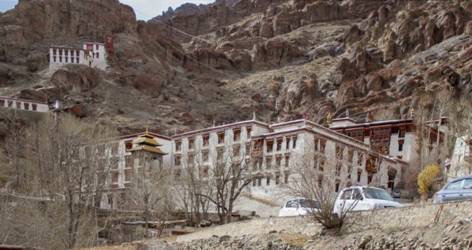
Image 1: Hemis Monastery, Ladakh
Pic Credit: sahapedia.org (Sanjay Dhar)
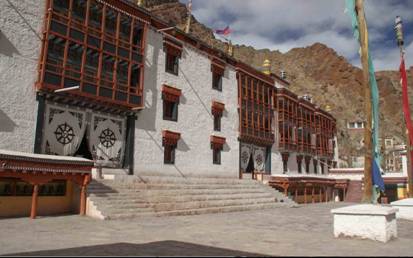
Image 2: Hemis Monastery, front façade
Pic Credit: sahapedia.org (Sanjay Dhar)
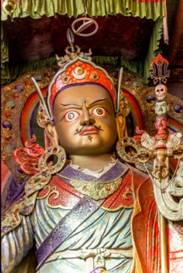
Image 3: Guru Padmasambhava
Pic Credit: sahapedia.org (Sanjay Dhar)
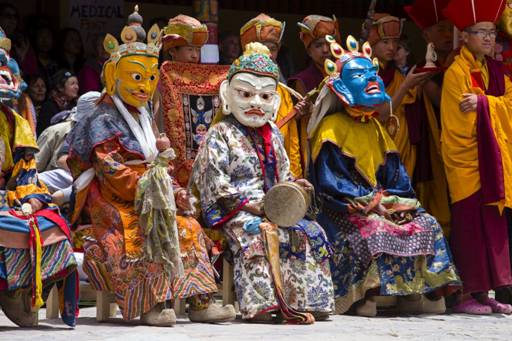
Image 4: Lamas dressed in mystical mask dance
Pic Credit: thestatesman.com

Image 5: Guru Padmasambhava during Cham dance
Pic Credit: sahapedia.org (Sanjay Dhar)
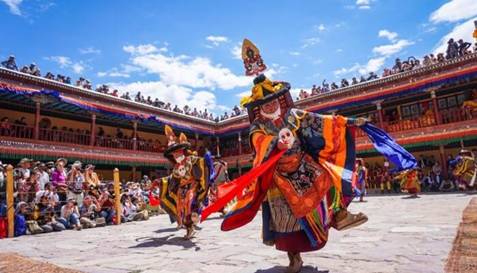
Image 6: Cham Dance
Pic Credit: traveltriangle.com
Bibliography
- Kapoor Subodh, The Indian Encyclopedia, Volume 14, Cosmo Publications, New Delhi, 2002
- M.L.A Gompertz, Magic Ladakh: An Intimate Picture of Land of Topsy-Turvy Customs & Great Natural Beauty, Asian Educational Services, 2000
- Sharma Usha, Festivals in Indian Society, Volume two, Mittal Publications, New Delhi, 2008
